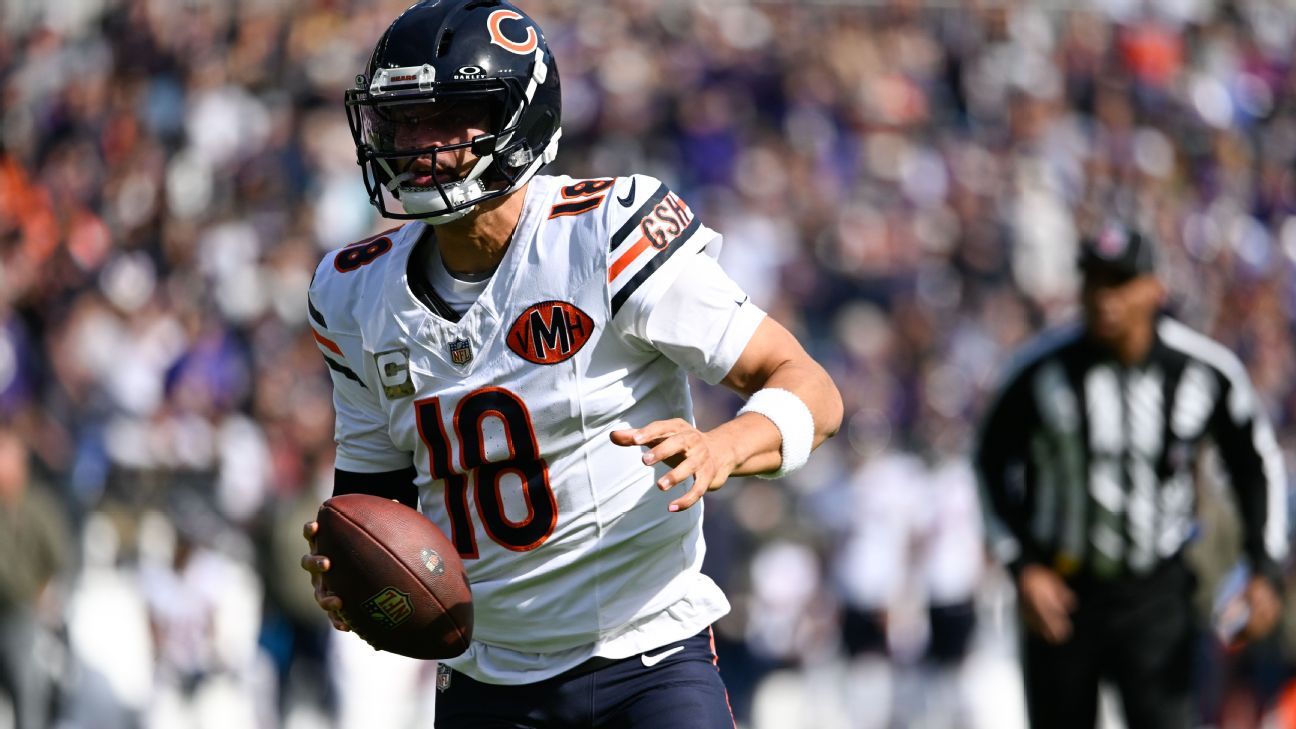![]()
Courtney CroninNov 1, 2025, 09:00 PM
CloseCourtney Cronin joined ESPN in 2017, originally covering the Minnesota Vikings before switching to the Chicago Bears in 2022. Courtney is a frequent panelist on Around the Horn and host of Best Week Ever and GameNight on ESPN Radio. She also co-hosts The Chicago Bears Podcast on ESPN 1000. She previously worked at the San Jose Mercury News as a multimedia sports journalist.
LAKE FOREST, Ill. — The Chicago Bears used half of the first quarter in Baltimore as they reached the red zone for the first time on their initial drive in Week 8. Throughout the opening frame in a 30-16 loss that snapped a four-game win streak, Chicago dominated. The Bears controlled the clock, ran 22 plays and picked up nine first downs.
But what has become a common theme in the red zone since Week 4 plagued Chicago once again.
The Bears’ first trip inside the Ravens’ 20-yard line yielded three points. After moving the ball so efficiently on the first drive of the game thanks to Rome Odunze‘s three receptions and a balanced dose of D’Andre Swift and Kyle Monangai on the ground, the offense fell into a familiar pattern.
A false start on tight end Colston Loveland at the 8-yard line was the first domino. Three plays later, Monangai was dropped for a 2-yard loss as the Bears failed to block Ravens linebacker Teddye Buchanan. Caleb Williams was then sacked by linebacker Mike Green on third down.
The Bears were forced to kick field goals on their first two drives, which traveled 64 and 61 yards, respectively. It has become a common outcome for Chicago over its past four games, when tone-setting drives have done little to keep an opponent on its heels.
“The red zone struggles have been on all of us,” Bears offensive coordinator Declan Doyle said. “As you look at them sequentially, pulling up that last game, you might look at it and say, ‘Hey, there’s one play,’ I look at it and say there’s four plays that if our precision and our detail is better on any one of those four plays, we probably come away with seven points in both of those first two drives.
“And that’s the thing that we have to really hone in on. There’s no magic answer. If there was, we’d be going out and doing it.”
Caleb Williams has identified several areas of improvement for the Bears in the red zone, including avoiding sacks and reducing penalties. Tommy Gilligan-Imagn Images
Red zone efficiency wasn’t an issue during Chicago’s first three games, when the Bears scored touchdowns on six of seven trips inside their opponent’s 20-yard line (85.7%). Even in a blowout loss to Detroit in Week 2, the Bears still scored seven points on both of their red zone appearances.
Since Chicago’s win in Las Vegas on Sept. 28, the Bears have the second-lowest red zone touchdown percentage (35.7%) and are averaging a league-low 3.9 points per red zone drive.
According to ESPN Research, Williams is the only quarterback without a red zone touchdown pass since Week 4 (with a minimum of four starts). Even running backs David Montgomery and Breece Hall have thrown TDs inside their opponent’s 20-yard line during that span.
Williams’ red zone efficiency during the Bears’ first three games was notable. His 100.0 QBR in the red zone ranked No. 1, and he threw four touchdowns and zero interceptions, completing 8 of 11 pass attempts. In his past four games, Williams’ red zone QBR dropped to 5.1, which ranks fourth worst in the NFL since Week 4. He has thrown an interception and completed only 8 of 17 pass attempts inside his opponent’s 20 during that span.
Swift gave Chicago its only red zone conversion when he ran in a 2-yard touchdown in the fourth quarter to cut Baltimore’s lead to 16-13. Williams’ interception later in the period with Chicago backed up in its own territory allowed for Baltimore to take a 23-13 lead.
Two possessions later, Chicago drove to Baltimore’s 3-yard line under the two-minute warning after Williams linked up with DJ Moore for 42 yards. The Bears then ran three plays inside Baltimore’s 3-yard line and got nowhere, including a failed quarterback sneak.
The Bears’ last attempt on fourth-and-goal fell incomplete when Williams missed a wide-open Moore in the back of the end zone. There was a discussion about whether Moore should have kept running or Williams just missed his target.
“For that particular play, [Moore is] running the back line,” coach Ben Johnson said. “He does have the ability to shut it down in an open window. It’s a unique look where there happens to be a second-level defender in the area, he shut it down. Do I wish he would have stayed on the move? Sure. I also know at this level, that’s open. We have two really good players right there, and we can find a way to hook up.”
Breaking news from Adam Schefter
Download the ESPN app and enable Adam Schefter’s news alerts to receive push notifications for the latest updates first. Opt in by tapping the alerts bell in the top right corner. For more information, click here.
As the Bears head to Cincinnati to take on a Bengals team that ranks 30th in red zone defense, there is an even higher urgency to score touchdowns.
Williams has identified several areas where his improvement in the red zone can yield more opportunities: Being conscious of when to use his legs to hurt a defense, progressing through his reads faster and not getting sacked inside the 20 are at the top of his list.
But the fix doesn’t solely fall on Williams’ shoulders.
“As a run game, as a pass game, and it comes down to details,” Williams said. “Run game, staying on landmarks, hitting the holes, and finding those, even if it’s not a gaping hole, getting those dirty 4 yards, 3 yards, because that goes a long way. And then the pass game is just being on the same page. And then, like, the one sack that I had down there in the beginning of the game, it’s just being able to either dirt it or find the back right there.
“Just being in those situations, finding checkdowns, being on the same page, being detailed, finding execution.”
Penalties have reached a critical juncture in Chicago. The Bears were flagged 11 times in Baltimore and are averaging two false-start penalties per game. Doyle said the Bears used “unorthodox” tactics in practice this week to find the fix for these pre-snap issues, though he declined to provide specifics on Chicago’s strategies to stop getting flagged.
Through seven games, the Bears have reached the red zone 23 times in 76 total drives. Ten of those 23 drives have featured an offensive penalty. Only three of Chicago’s 11 red zone touchdowns have come on a drive with a penalty, while five of 16 total touchdown drives this season have included a penalty.
“We have them at terrible times,” right tackle Darnell Wright said. “Not to say it’s ever good to have [penalties], but the worst times to have them would be third down and the red zone. That’s when you’re most amped up to do your job, so it makes sense that it would show over there, but we need to focus in more at those times.”


